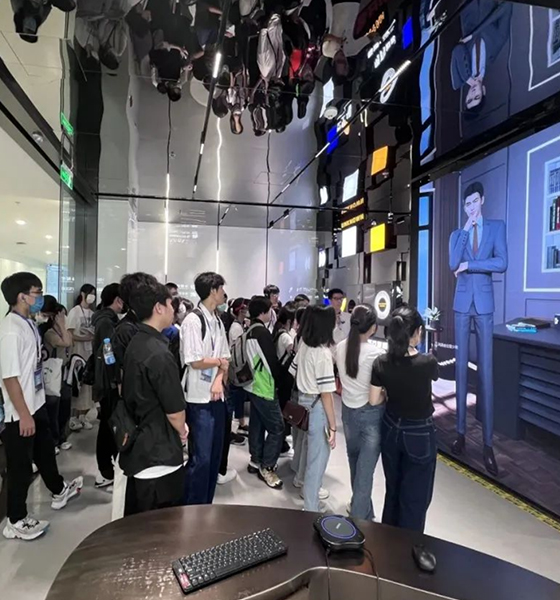 2024-10-12 15:01:38
2024-10-12 15:01:38

The rise of AI technology has transformed numerous industries, and trade shows are no exception. AI Virtual Human Kiosks are revolutionizing how businesses and exhibitors interact with visitors, creating smarter, more engaging experiences. From personalized interactions to real-time responses, AI kiosks powered by virtual human technology provide exhibitors with a competitive edge, enhancing trade show effectiveness.
In this article, we’ll explore how AI Virtual Human Kiosks boost trade show performance, improve visitor engagement, and streamline operations, all while offering a seamless and interactive experience. We'll also discuss the technological aspects behind these systems, such as 3D virtual human avatars and voice interaction capabilities, that make AI kiosks an essential tool for the service industry.
AI Virtual Human Kiosks are transforming traditional kiosks by integrating lifelike 3D avatars capable of real-time communication with trade show visitors. These kiosks are equipped with artificial intelligence to provide tailored information, guide users through product demonstrations, and respond to questions. Let's look at the key benefits that make them an essential part of any successful trade show:
Smart, Personalized Interactions
AI Virtual Human Kiosks use data and analytics to offer personalized experiences based on user preferences, interests, and behavior. They can recognize returning visitors and provide recommendations, making each interaction feel relevant and engaging. For instance, a visitor interested in a specific product can receive customized details or demonstrations based on their previous interactions.
Instant and Accurate Responses
One of the biggest advantages of AI Virtual Humans is their ability to provide instant and accurate responses. These kiosks eliminate the need for waiting, as they can handle multiple queries simultaneously. Powered by natural language processing (NLP) and machine learning, these systems can answer complex questions with ease, ensuring visitors always get the information they need.
24/7 Availability
Unlike human staff, AI Virtual Human Kiosks can operate around the clock, ensuring visitors receive assistance at any time during the trade show. This constant availability helps businesses maximize engagement, even during off-peak hours.
Language Flexibility
AI kiosks are multilingual, making them ideal for international trade shows. These systems can switch between languages, allowing exhibitors to interact with a global audience effortlessly. With the ability to cater to diverse linguistic needs, businesses can reach a broader customer base, enhancing their chances of success.
Seamless Voice Interaction
AI kiosks come equipped with voice interaction capabilities, making communication natural and intuitive. Visitors can engage in conversations with the virtual human, ask for detailed product information, or request guidance, all through voice commands. This hands-free interaction is especially convenient in busy trade show environments where visitors may be juggling multiple activities.
Data Collection and Insights
AI Virtual Human Kiosks can collect valuable data about visitor interactions, providing businesses with insights into customer preferences and behavior. By analyzing this data, companies can adjust their strategies in real-time, improving their exhibit performance. For instance, a booth that notices high interest in a particular product can pivot to focus on that product in future conversations or marketing efforts.
Several technological advancements make AI Virtual Human Kiosks effective tools at trade shows:
3D Virtual Human Avatars
These kiosks feature lifelike 3D avatars, designed to create an inviting and friendly user experience. The avatars are customizable, allowing exhibitors to design a virtual human that aligns with their brand's personality. These avatars can express emotions, gestures, and body language, making interactions more natural and engaging.
Voice Recognition and NLP
AI Virtual Human Kiosks are equipped with advanced voice recognition and natural language processing (NLP) systems. This allows the kiosk to understand and respond to verbal commands in real-time. By using voice interaction, visitors can effortlessly engage with the kiosk, making the experience smoother and more interactive.
Machine Learning for Continuous Improvement
Machine learning algorithms enable the kiosk to improve over time by learning from each interaction. This ensures that the virtual human's responses become more accurate and relevant as it interacts with more visitors. Machine learning also helps in understanding trends and preferences, enabling better recommendations and solutions for future trade shows.
For businesses participating in trade shows, AI Virtual Human Kiosks provide numerous advantages, including:
Cost Efficiency
AI kiosks can handle multiple interactions simultaneously, reducing the need for a large team of staff members. This saves businesses money on labor costs while providing high-quality customer service.
Scalability
With AI Virtual Human Kiosks, exhibitors can scale their operations effortlessly. Whether the trade show attracts a few hundred visitors or thousands, AI kiosks ensure that each guest receives the same level of attention and service.
Consistency
AI Virtual Humans provide consistent responses, eliminating the variability in human-to-human interactions. This ensures that every visitor has a similar experience, which helps to maintain the brand’s image and message throughout the event.
Increased Visitor Engagement
By offering personalized and real-time interactions, AI kiosks create a more engaging experience for visitors. This increases the likelihood of converting leads into customers, as visitors feel more informed and valued.
As AI technology continues to evolve, so will the capabilities of AI Virtual Human Kiosks. Future advancements may include more sophisticated emotional recognition, allowing kiosks to adjust their tone and behavior based on the visitor’s mood. Additionally, integration with augmented reality (AR) could provide even more immersive experiences, allowing visitors to interact with products in a virtual environment.
In the coming years, AI Virtual Human Kiosks will likely become a standard feature at trade shows and other large-scale events. Their ability to enhance customer engagement, streamline operations, and provide valuable insights makes them indispensable tools for businesses looking to succeed in a competitive environment.
